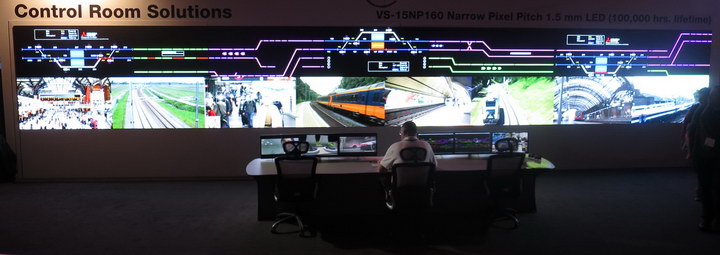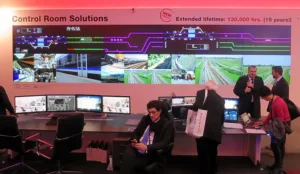Mitsubishi Electric offered three new display products at ISE: 130K hour life RP cubes for control rooms; an LED RP engine replacement for Mitsubishi and other brands of RP cubes; and a direct view LED wall specifically designed for use in control rooms. In addition, they offered a new, native IP-based control room visualization software, the S-SF software suite. The S-SF software is intended primarily for new installations, not retrofitting existing control rooms.
The S-SF suite consists of five applications; Display Agent, Multicast Adaptor, Application Server, Operator GUI and Master Controller. Together, they create a native IP-based system capable of handling data traffic from any networked source device, such as sensors, image processors, CCTV cameras or data stores, and then synchronizing and sharing the content instantly across any number of locations with minimal latency.
Using the S-SF architecture, control room video walls no longer require a dedicated display wall processor. Fault tolerance is assured due to the multiple redundancies inherent in the distributed network architecture. If one network node develops a fault, its role is instantly assigned to another node to achieve a completely seamless fail-safe response and guaranteed 24/7, zero-downtime performance. The S-SF system hardware is based on standard, widely-available network components, thereby removing the need to develop and debug proprietary hardware or operating systems. The result is said to be a more reliable, cost-efficient system.
A 5 wide by 2 high array of Mitsubishi VS-72WE120U cubes in a simulated control room environment. (Credit: M. Brennesholtz)
Mitsubishi announced at ISE that the operational lifespan of its WE120 family of DLP cube engines has been increased to an astonishing 130,000 hours, or nearly 15 years of continuous 24/7 operation in all brightness modes, topping the previous industry record of 100,000 hours – already held by Mitsubishi’s WE120 – by nearly 30%.
Mitsubishi’s Peter van Dijk commented,
“Minimizing cost of ownership while guaranteeing first-class performance and reliability is our objective. The greatly extended operational life of the WE120 coupled with its zero-maintenance design, makes it, we believe, the most competitive high-end command & control DLP video wall solution currently available.”
Mitsubishi is a market leader in control room displays, with over 78,000 of its cubes installed world-wide.
The WE120 Series model range includes 60” and 70” Full HD, and 62” and 72” WUXGA displays in both rear access and front access variants. All new models now offer a minimum 130,000 hours of continuous operation and a full range of features, including DVI inputs and OPS slots. Mitsubishi’s proprietary digital graduation and colour space control technologies have been incorporated into the WE120 and its air-cooled LED light source requires no routine maintenance, ensuring that maintenance costs are virtually eliminated for its entire 15-year lifespan.
 Mitsubishi’s VS-PE78RU replacement LED RP engine. (Credit: M. Brennesholtz)
Mitsubishi’s VS-PE78RU replacement LED RP engine. (Credit: M. Brennesholtz)
Mitsubishi has introduced a family of universal upgrade engines said to fit in most RP cubes with older lamp- or LED-based RP cubes manufactured in the last 15 years. By replacing the engines in a cube array with the Mitsubishi 100,000 hour upgrade engines, the life of the cube array can be extended by about 11 years. The VS-PE78RU on static display at ISE was a 4:3 SXGA+ (1400 x 1050) engine intended to fit in cubes with 50” or 67” diagonals. It can produce 1620 cd/m² at the screen and has a contrast ratio of 1600:1. There are two other versions Mitsubishi universal upgrade engines with SXGA+ resolution at reduced brightness plus two versions with XGA (1,024 by 768) resolution. All versions of the upgrade engine have redundant RGB LED light sources. LEDs will provide significantly improved colorimetry if you are replacing lamp-based cube engines.
Since Christie has exited the RP cube market, owners of Christie videowalls nearing the end of life might be especially interested in getting in touch with Mitsubishi on these upgrade engines.
 Mitsubishi VS-15NP160 modules at ISE in a simulated control room environment. (Credit: M. Brennesholtz)
Mitsubishi VS-15NP160 modules at ISE in a simulated control room environment. (Credit: M. Brennesholtz)
Control Room LEDs Have Depth in Technology
Mitsubishi showed a massive 11m x 1.6m (36.1’ x 5.2’) control room display simulation built using the company’s latest display technology, narrow pixel pitch (NPP) LED videowall modules. The display is said to be the largest system of its kind seen in public.
The recently launched VS-15NP160 (15-NP) module is the first direct view LED screen designed specifically for command and control applications, and incorporates many of the key technologies of Mitsubishi’s DLP and LCD displays, along with several patented features which enhance long-term reliability, energy efficiency and performance. The addition of direct view LED to its portfolio allows Mitsubishi Electric to offer a full choice of technologies for large-scale control room display projects, it believes.
Designed and built by Mitsubishi Electric in Japan under stringent quality control, the 15-NP delivers a light output of 800 cd/m², which together with its high contrast ratio and completely seamless screen surface, makes it an ideal choice for SCADA (Supervisory Control and Data Acquisition)-type applications. A new patented anti-burn feature allows static graphics to be displayed for long periods of time without adversely affecting performance or lifespan. The 15-NP is rated for 100,000 hours of continuous operation, with its anti-burn feature ensuring that LED luminance and chromaticity remains uniform over the life time of the screen.
With the 15-MP module, it is possible to create daylight-viewable displays of any size. Display depth of only 90mm means that it can be installed virtually anywhere, and both front and rear access versions are available to further increase versatility.
The 15-NP is based on a 1.5mm pitch, 3-in-1 SMD LED package developed especially for this application by Mitsubishi Electric, using over 30 years of experience derived from its Diamond Vision outdoor screen system. Displays are assembled on site as required from individual LED cabinets measuring 480mm x 540mm.
The LED units feature standard OPS slots, which can accommodate OPS 3G-SDI-input boards or OPS HDBaseT inputs for long-distance signal transmission via CAT6(STP) cable. Dual-loop signal inputs and redundant power supplies ensure the display will continue to function in the event of an LED unit power failure. Dynamic power consumption features actively monitor image luminance and adjust power output accordingly to optimize power consumption and reduce operator eye-fatigue – a critical factor in control room applications not addressed by general purpose direct view LED displays. Mitsubishi has also incorporated the Natural Color Matrix system found in its DLP products into the 15-NP, along with a specially developed 2-dimensional noise reduction system to reduce visible noise in compressed content such as MPEG video. –Matthew Brennesholtz

